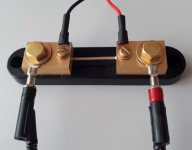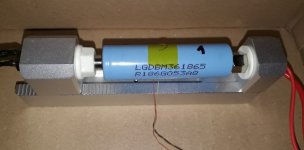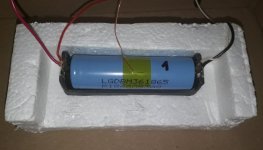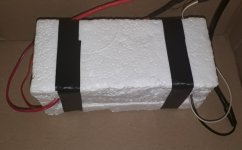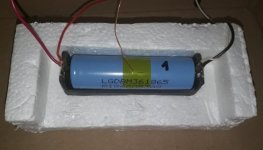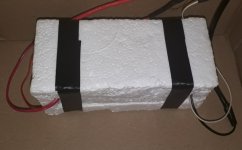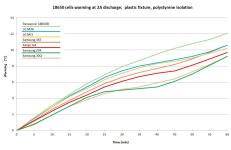thunderheart
100 W
Original article: https://www.thunderheartreviews.com/2018/09/lg-m36-vs-samsung-36g-capacity-test.html
The first 3600mAh Li-ion battery in 18650 format appeared 4-5 years ago. It was Panasonic NCR18650G. But it disappeared from the market very quickly and since then there was no 3600mAh cell you could buy (except fakes on eBay). Now two of top manufacturers, LG and Samsung, offer their cells, which are being sold as 3600mAh ones - LG INR18650 M36T and Samsung INR18650-36G. Both cells were bought from Queen Battery.
The video version of this test for those who prefer watching rather than reading:

As always the tests were done using ZKETECH EBC-A20, which supports up to 20A discharge, 4-wire measurement and is PC-connected.

I've upgraded my battery holder to version 3.0

This time i've used thicker (0.5mm) pure copper strips (9mm and 11.5mm wide). The parts which contact with the cell are rised a bit to provide reliable connection when a cell with deep placed contact(s) is held.
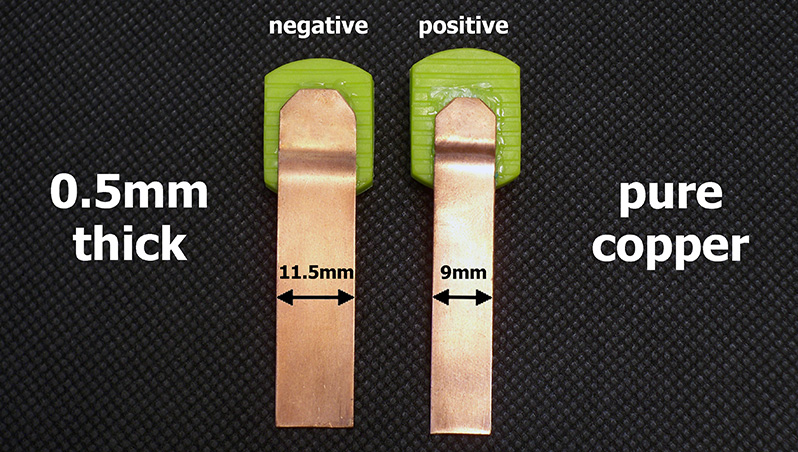
I've followed all the prescriptions of the IEC61960-2003 standard concerning battery's capacity measurement. Before each discharging cycle each battery was charged at standard current mentioned in its datasheet to charge end voltage (4.2V) (cut-off at 0.1A, which is the lowest supported by EBC-A20). Before each discharging or charging i've held a 1-1.5hrs pause. The environment temperature was 23.5-24.5°C. To be sure in results i've done each test minimum twice.
When i was testing these cells there was no datasheet available for either of them so i decided to use the following values for testing both guys:
Standard charge current: 1.80A
Charge end voltage: 4.2V
Charge cut-off current: 100mA
Max discharge current: 10A
Discharge cut-off voltage: 2.5V
LG INR18650 M36T
My cell has the following marking: LGDBM361865 Q248I053A1. According to BatteryBro Q248 means that the production date is Sep 2017.
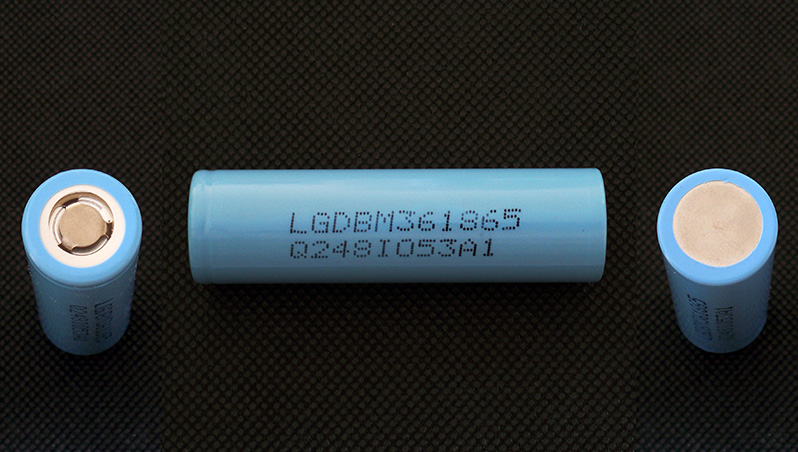
Specifications from LG M36 datasheet (pdf):
Nominal energy: 12.50Wh
Minimum energy: 12.10Wh
Nominal voltage: 3.63V
Standard charge current: 1000mA (0.3C)
Charge end voltage: 4.2V
Charge cut-off current: 50mA
Max. charge current: 1000mA (0.3C) at 0-24°C, 2330mA (0.7C) at 24-50°C
Max. discharge current: 5000mA
Discharge cut-off voltage: 2.5V
AC impedance at 1KHz: ≤30mΩ
Maximum weight: 48.2 ± 1.0g
I remind that the datasheet i found (thank Pajda) after testing and the specs above are just for information.
Pay attention that there is no capacity mentioned in the datasheet, but the 0.2C current is mentioned as 670mA, so it's not hard to find the C (capacity): 670/0.2=3350mAh. It corresponds to the "minimum capacity" i think, because 3.35x3.63=12.16Wh. The nominal capacity would be 12.50/3.63=3.444Ah ≈3450mAh.
Also pay attention to the Max discharge current in the datasheet - it's 5A, not 10A as the suppliers tell. Though i'm not sure it's not a mistake.
The measured weight of my M36 cell is 48.40g
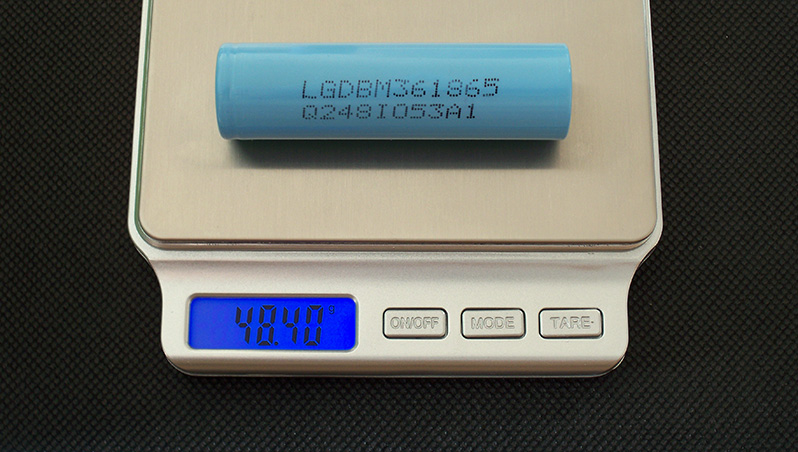
Capacity test results:
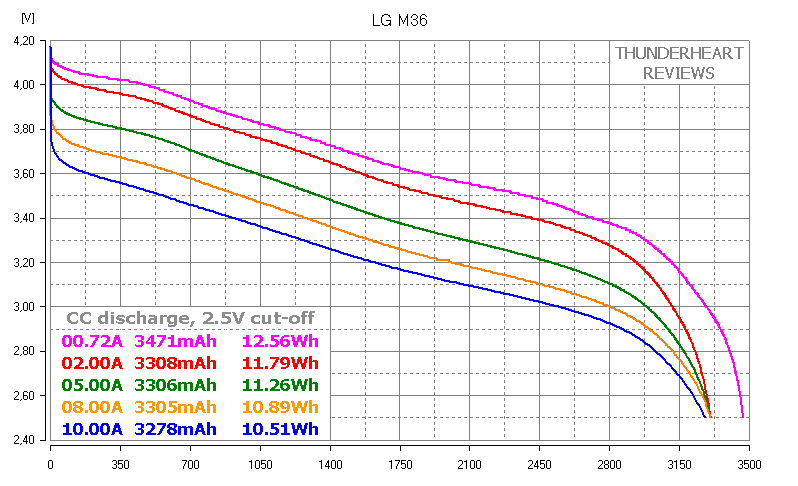
At 0.72A which is higher than 0.2C mentioned in the datasheet (0.67A) M36 showed 3471mAh and 12.56Wh - more than the nominal energy declared. All the curves, including at 8A and 10A, look excellent and that's why i think that the max discharge current is not 5A as mentioned in the datasheet.
Samsung INR18650-36G
The cell which i've tested has the following marking: INR18650-36G SAMSUNG SDI 2H24. H24 means that the cell was manufactured in Feb 2017.
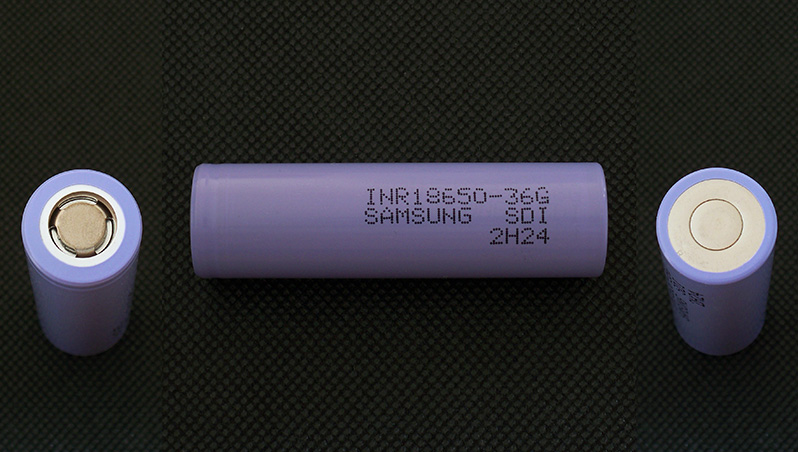
The measured weight of my cell is 47.97g
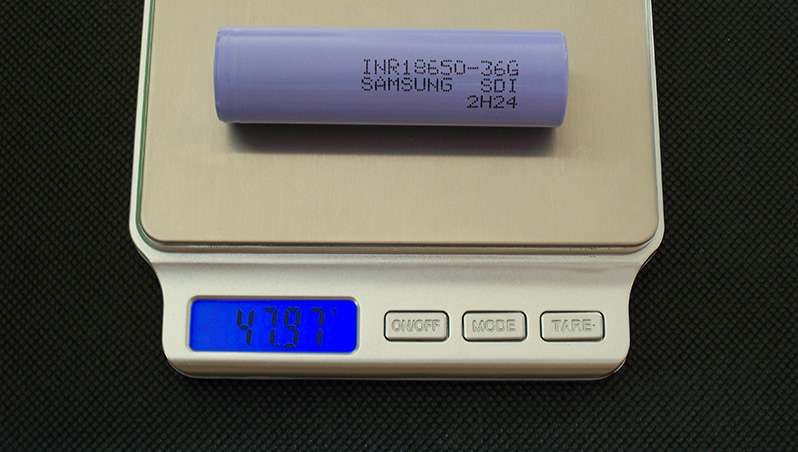
Samsung 36G capacity test results:
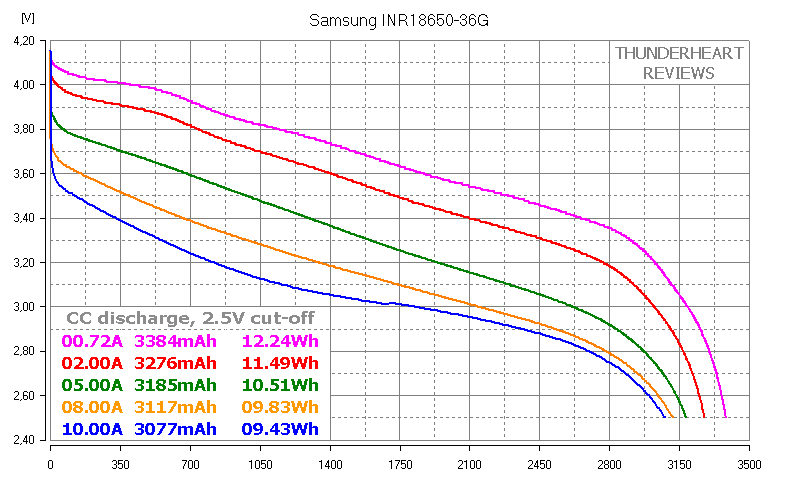
At 0.72A capacity is below 3400mAh and at 10A the curve shows a deep voltage sag which is not a good sign. I would not recommend discharging 36G at current higher than 8A.
COMPARISON
Let's start with 2A discharge:
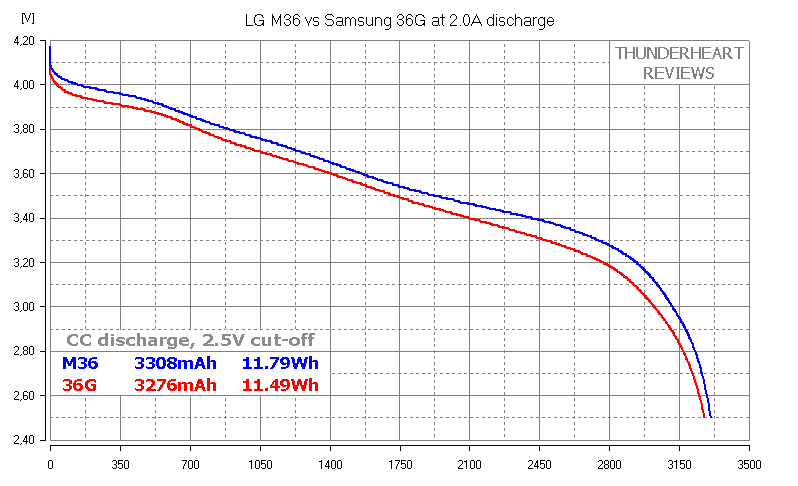
M36 is the winner. The difference is about 30mAh in capacity and 0.3Wh in energy.
At 5A discharge:
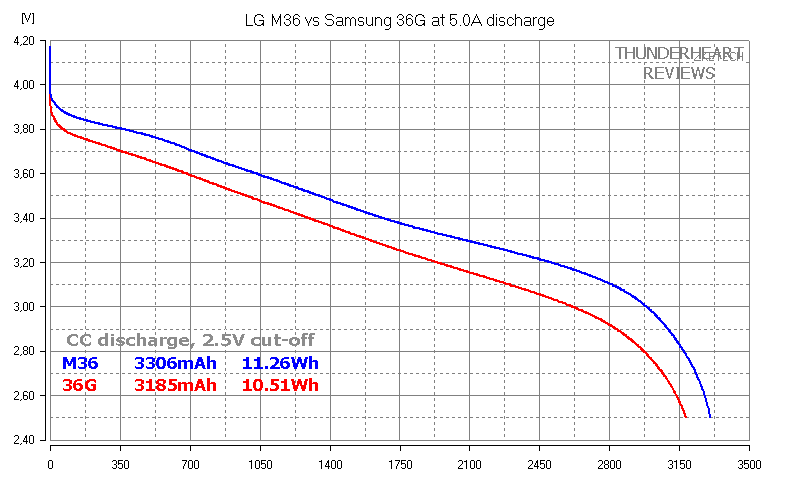
Picture didn't change - M36 is the better one but the difference is already about 120mAh / 0.75Wh.
At 8A discharge:
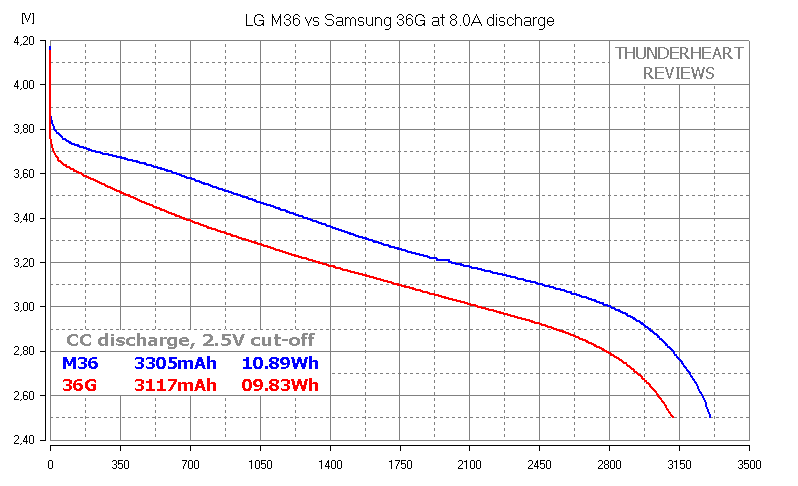
At 8A the gap reached 190mAh and 1Wh...
At 10A discharge:
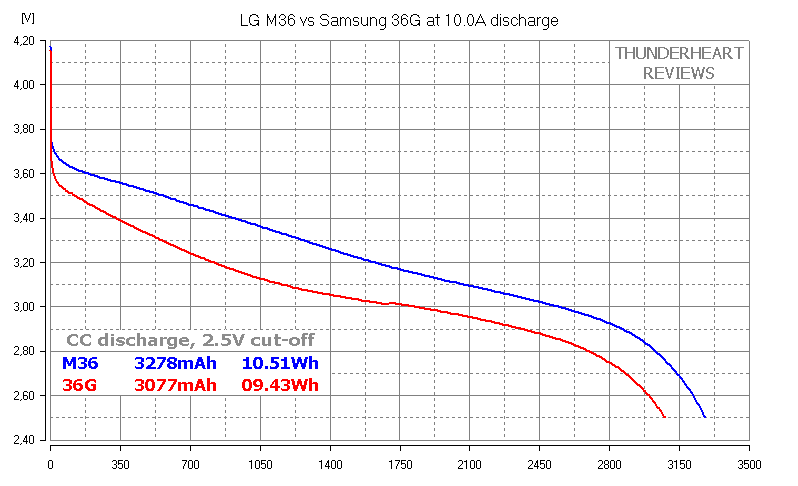
M36 outperformed 36G by 200mAh and 1.1Wh but 36G doesn't look confident at 10A.
CONCLUSION
None of two cells can be called a 3600mAh battery... Samsung 36G doesn't even reach the 3400mAh point... LG M36 is comparable with 3500mah cells which i've tested but doesn't outperform them all.
Queen Battery sells Samsung 36G for USD 2.90 and LG M36 for USD 3.00 (shipping not included).
UPDATE: Queen Battery doesn't sell Samsung 36G due to its poor performance. It turned out they stopped selling them a month ago.
Check out my YouTube channel for batteries, chargers and other stuff reviews.
I've recently launched my blog where you can find all my reviews in one place. Every new test/review will be first published on YouTube and in the blog. I'll be happy to see new subscribers, comments, suggestions and just your thoughts.
The first 3600mAh Li-ion battery in 18650 format appeared 4-5 years ago. It was Panasonic NCR18650G. But it disappeared from the market very quickly and since then there was no 3600mAh cell you could buy (except fakes on eBay). Now two of top manufacturers, LG and Samsung, offer their cells, which are being sold as 3600mAh ones - LG INR18650 M36T and Samsung INR18650-36G. Both cells were bought from Queen Battery.
The video version of this test for those who prefer watching rather than reading:

As always the tests were done using ZKETECH EBC-A20, which supports up to 20A discharge, 4-wire measurement and is PC-connected.

I've upgraded my battery holder to version 3.0

This time i've used thicker (0.5mm) pure copper strips (9mm and 11.5mm wide). The parts which contact with the cell are rised a bit to provide reliable connection when a cell with deep placed contact(s) is held.

I've followed all the prescriptions of the IEC61960-2003 standard concerning battery's capacity measurement. Before each discharging cycle each battery was charged at standard current mentioned in its datasheet to charge end voltage (4.2V) (cut-off at 0.1A, which is the lowest supported by EBC-A20). Before each discharging or charging i've held a 1-1.5hrs pause. The environment temperature was 23.5-24.5°C. To be sure in results i've done each test minimum twice.
When i was testing these cells there was no datasheet available for either of them so i decided to use the following values for testing both guys:
Standard charge current: 1.80A
Charge end voltage: 4.2V
Charge cut-off current: 100mA
Max discharge current: 10A
Discharge cut-off voltage: 2.5V
LG INR18650 M36T
My cell has the following marking: LGDBM361865 Q248I053A1. According to BatteryBro Q248 means that the production date is Sep 2017.

Specifications from LG M36 datasheet (pdf):
Nominal energy: 12.50Wh
Minimum energy: 12.10Wh
Nominal voltage: 3.63V
Standard charge current: 1000mA (0.3C)
Charge end voltage: 4.2V
Charge cut-off current: 50mA
Max. charge current: 1000mA (0.3C) at 0-24°C, 2330mA (0.7C) at 24-50°C
Max. discharge current: 5000mA
Discharge cut-off voltage: 2.5V
AC impedance at 1KHz: ≤30mΩ
Maximum weight: 48.2 ± 1.0g
I remind that the datasheet i found (thank Pajda) after testing and the specs above are just for information.
Pay attention that there is no capacity mentioned in the datasheet, but the 0.2C current is mentioned as 670mA, so it's not hard to find the C (capacity): 670/0.2=3350mAh. It corresponds to the "minimum capacity" i think, because 3.35x3.63=12.16Wh. The nominal capacity would be 12.50/3.63=3.444Ah ≈3450mAh.
Also pay attention to the Max discharge current in the datasheet - it's 5A, not 10A as the suppliers tell. Though i'm not sure it's not a mistake.
The measured weight of my M36 cell is 48.40g

Capacity test results:

At 0.72A which is higher than 0.2C mentioned in the datasheet (0.67A) M36 showed 3471mAh and 12.56Wh - more than the nominal energy declared. All the curves, including at 8A and 10A, look excellent and that's why i think that the max discharge current is not 5A as mentioned in the datasheet.
Samsung INR18650-36G
The cell which i've tested has the following marking: INR18650-36G SAMSUNG SDI 2H24. H24 means that the cell was manufactured in Feb 2017.

The measured weight of my cell is 47.97g

Samsung 36G capacity test results:

At 0.72A capacity is below 3400mAh and at 10A the curve shows a deep voltage sag which is not a good sign. I would not recommend discharging 36G at current higher than 8A.
COMPARISON
Let's start with 2A discharge:

M36 is the winner. The difference is about 30mAh in capacity and 0.3Wh in energy.
At 5A discharge:

Picture didn't change - M36 is the better one but the difference is already about 120mAh / 0.75Wh.
At 8A discharge:

At 8A the gap reached 190mAh and 1Wh...
At 10A discharge:

M36 outperformed 36G by 200mAh and 1.1Wh but 36G doesn't look confident at 10A.
CONCLUSION
None of two cells can be called a 3600mAh battery... Samsung 36G doesn't even reach the 3400mAh point... LG M36 is comparable with 3500mah cells which i've tested but doesn't outperform them all.
Queen Battery sells Samsung 36G for USD 2.90 and LG M36 for USD 3.00 (shipping not included).
UPDATE: Queen Battery doesn't sell Samsung 36G due to its poor performance. It turned out they stopped selling them a month ago.
Check out my YouTube channel for batteries, chargers and other stuff reviews.
I've recently launched my blog where you can find all my reviews in one place. Every new test/review will be first published on YouTube and in the blog. I'll be happy to see new subscribers, comments, suggestions and just your thoughts.



